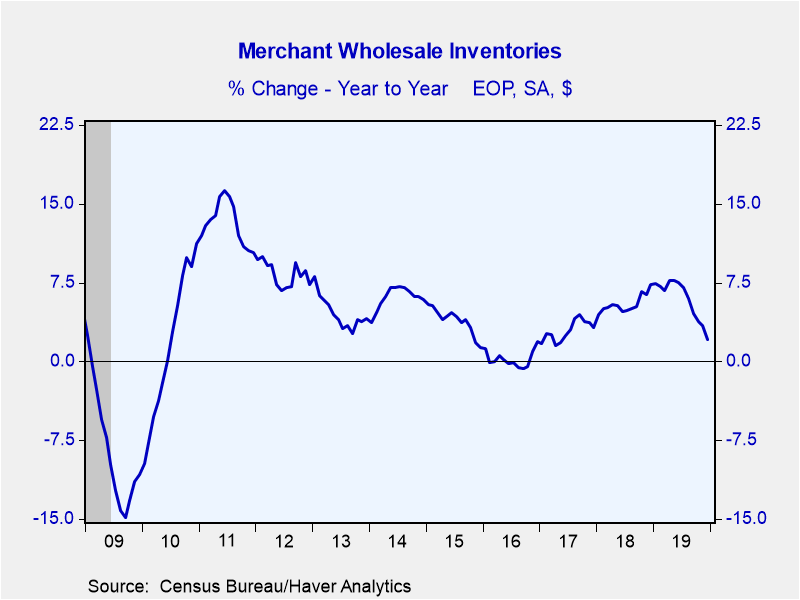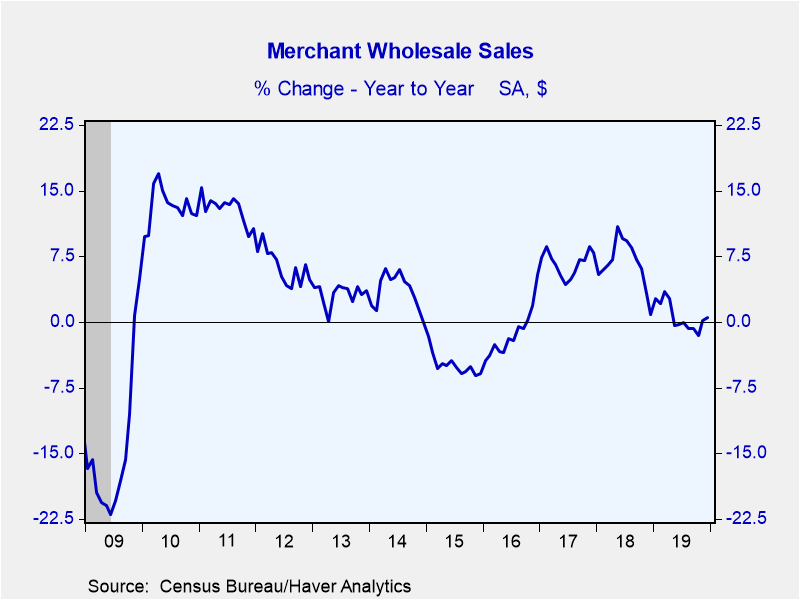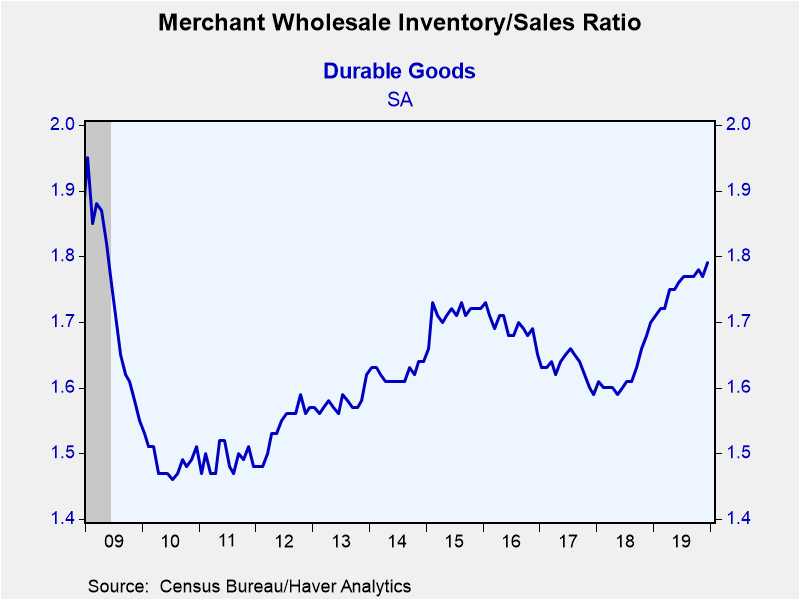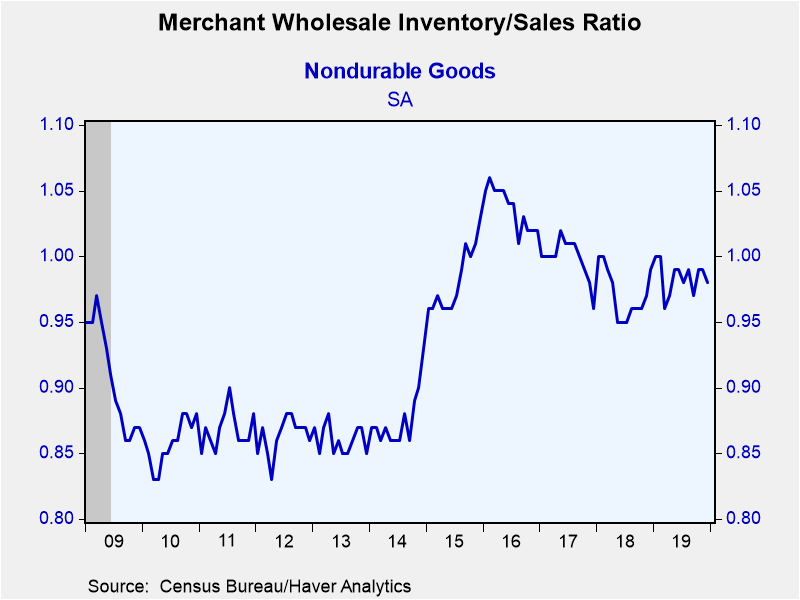 Global| Feb 07 2020
Global| Feb 07 2020Wholesale Inventories and Sales Fall in December
by:Sandy Batten
|in:Economy in Brief
Summary
Wholesale inventories edged down 0.2% m/m (+2.1% y/y) in December after an upwardly revised 0.1% m/m rise in November (initially -0.1% m/m). The Informa Global Markets Survey anticipated a 0.1% decline in December. For all of Q4, [...]
Wholesale inventories edged down 0.2% m/m (+2.1% y/y) in December after an upwardly revised 0.1% m/m rise in November (initially -0.1% m/m). The Informa Global Markets Survey anticipated a 0.1% decline in December. For all of Q4, wholesale inventories fell 0.1% q/q but for all of 2019 they rose 2.1% y/y. Wholesale inventory swings can have a meaningful impact on GDP growth. In the first estimate of 2019 Q4 GDP, a sharp slowdown in inventory investment subtracted 1.1%-points from overall real GDP growth.
Durable goods inventories decreased 0.3% (+1.2% y/y) in December after a 0.5% decline in November. The December decline was widely spread across major categories and was led by a 1.2% m/m drop in inventories of computing equipment and a 1.1% m/m decline in metals inventories. Inventories of nondurable goods were unchanged in December from November (+3.7% y/y) with a 7.8% m/m jump in petroleum inventories offset by declines across most other categories.
Wholesale sales disappointed in December, falling 0.7% m/m (+0.5% y/y) against the Action Economics Forecast Survey expectation for a 0.1% m/m gain. And the originally reported 1.5% m/m gain in November was revised down to 0.9%. For Q4, sales fell 0.7% q/q but for all of 2019 they edged up 0.6% y/y.
Weaker durable goods sales were behind the overall December decline. Sales of durable goods slumped 1.9% m/m (-4.0% y/y). Of note, motor vehicle sales fell 4.1% m/m, machinery sales declined 3.6% m/m and sales of metals decreased 3.5% m/m. In contrast, sales of nondurable goods rose 0.4% m/m (+4.8% y/y) on top of a 1.3% m/m jump in November. Monthly increases were widely spread, led by 4.8% m/m jump in sales of chemicals.
The inventory-to-sales (I/S) ratio at the wholesale level was unchanged in December at an upwardly revised 1.36 (initially reported as 1.35 for November). The I/S ratio has been either 1.36 or 1.37 for the past eight months after having generally risen since the middle of 2018. The durable goods I/S ratio rose to 1.79 in December, its highest reading since the Great Recession in 2008-09. The December increase was led by jumps in the I/S ratio for motor vehicles and for machinery. The I/S ratio for nondurables goods slipped to 0.98 in December from 0.99.
The wholesale trade figures are available in Haver's USECON database. The expectations figure for inventories is contained in the MMSAMER database. Expectations for sales are in the AS1REPNA database.
| Wholesale Sector - NAICS Classification (%) | Dec | Nov | Oct | Dec Y/Y | 2019 | 2018 | 2017 |
|---|---|---|---|---|---|---|---|
| Inventories | -0.2 | 0.1 | 0.1 | 2.1 | 2.1 | 7.3 | 3.3 |
| Sales | -0.7 | 0.9 | -0.9 | 0.5 | 0.6 | 6.7 | 6.7 |
| I/S Ratio | 1.36 | 1.36 | 1.37 | 1.34 (Dec '18) | 1.36 | 1.29 | 1.30 |
Sandy Batten
AuthorMore in Author Profile »Sandy Batten has more than 30 years of experience analyzing industrial economies and financial markets and a wide range of experience across the financial services sector, government, and academia. Before joining Haver Analytics, Sandy was a Vice President and Senior Economist at Citibank; Senior Credit Market Analyst at CDC Investment Management, Managing Director at Bear Stearns, and Executive Director at JPMorgan. In 2008, Sandy was named the most accurate US forecaster by the National Association for Business Economics. He is a member of the New York Forecasters Club, NABE, and the American Economic Association. Prior to his time in the financial services sector, Sandy was a Research Officer at the Federal Reserve Bank of St. Louis, Senior Staff Economist on the President’s Council of Economic Advisors, Deputy Assistant Secretary for Economic Policy at the US Treasury, and Economist at the International Monetary Fund. Sandy has taught economics at St. Louis University, Denison University, and Muskingun College. He has published numerous peer-reviewed articles in a wide range of academic publications. He has a B.A. in economics from the University of Richmond and a M.A. and Ph.D. in economics from The Ohio State University.










